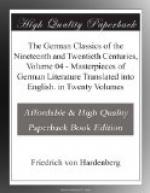The similarity of the English and Spanish theatres does not consist merely in the bold neglect of the Unities of Place and Time, or in the commixture of comic and tragic elements; that they were unwilling or unable to comply with the rules and with right reason (in the meaning of certain critics these terms are equivalent), may be considered as an evidence of merely negative properties. The ground of the resemblance lies far deeper, in the inmost substance of the fictions and in the essential relations through which every deviation of form becomes a true requisite, which, together with its validity, has also its significance. What they have in common with each other is the spirit of the romantic poetry, giving utterance to itself in a dramatic shape. However, to explain ourselves with due precision, the Spanish theatre, in our opinion, down to its decline and fall in the commencement of the eighteenth century, is almost entirely romantic; the English is completely so in Shakespeare alone, its founder and greatest master; but in later poets the romantic principle appears more or less degenerated, or is no longer perceivable, although the march of dramatic composition introduced by virtue of it has been, outwardly at least, pretty generally retained. The manner in which the different ways of thinking of the two nations, one a northern and the other a southern, have been expressed; the former endowed with a gloomy, the latter with a glowing imagination; the one nation possessed of a scrutinizing seriousness disposed to withdraw within itself, the other impelled outwardly by the violence of passion—the mode in which all this has been accomplished will be most satisfactorily explained at the close of this section, when we come to institute a parallel between Shakespeare and Calderon, the only two poets who are entitled to be called great.
Of the origin and essence of the romantic I treated in my first Lecture, and I shall here, therefore, merely briefly mention the subject. The ancient art and poetry rigorously separate things which are dissimilar; the romantic delights in indissoluble mixtures; all contrarieties—nature and art, poetry and prose, seriousness and mirth, recollection and anticipation, spirituality and sensuality, terrestrial and celestial, life and death, are by it blended in the most intimate combination. As the oldest law-givers delivered their mandatory instructions and prescriptions in measured melodies; as this is fabulously ascribed to Orpheus, the first softener of the yet untamed race of mortals; in like manner the whole of ancient poetry and art is, as it were, a rhythmical nomos (law), a harmonious promulgation of the permanently established legislation of a world submitted to a beautiful order and reflecting in itself the eternal images of things. Romantic poetry, on the other hand, is the expression of the secret attraction to a chaos which lies concealed in the very bosom of the ordered universe, and is perpetually




